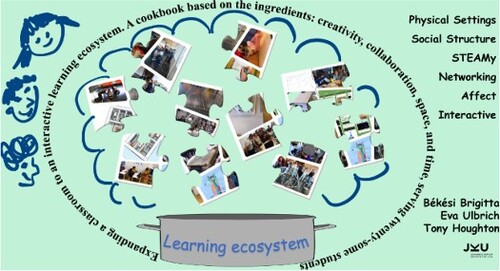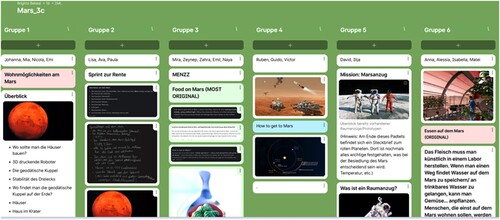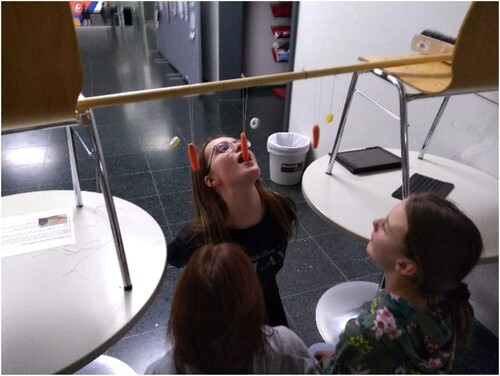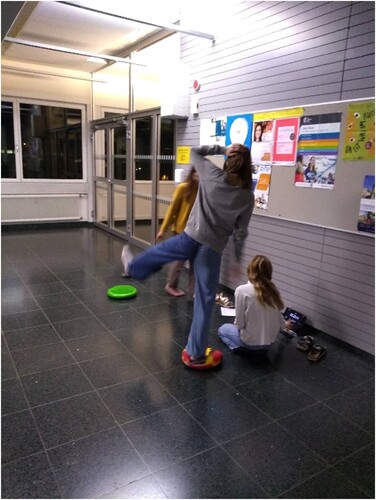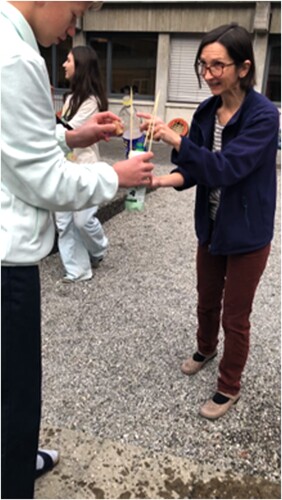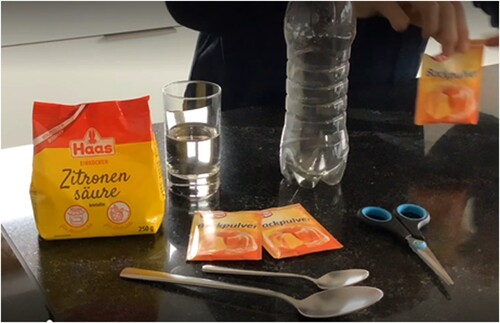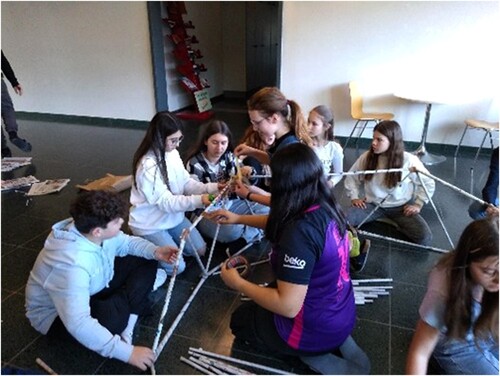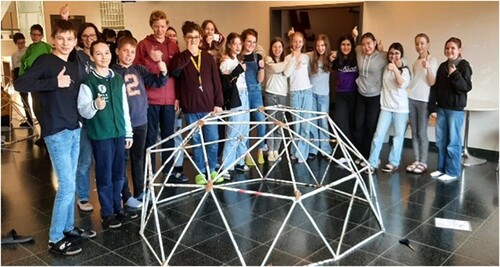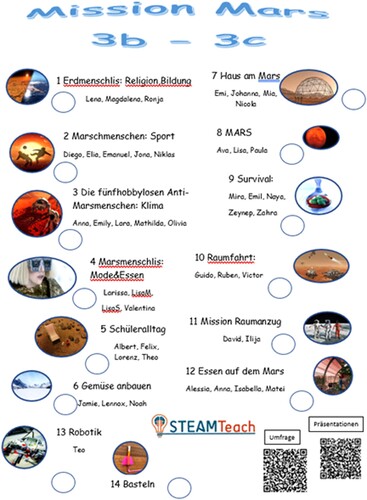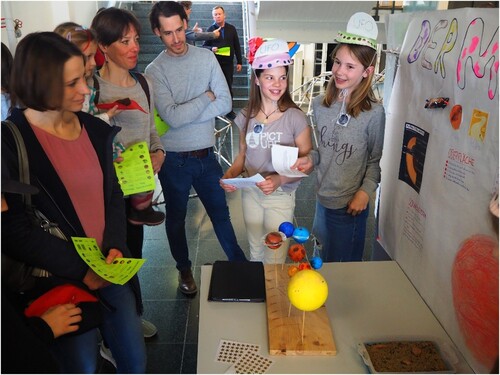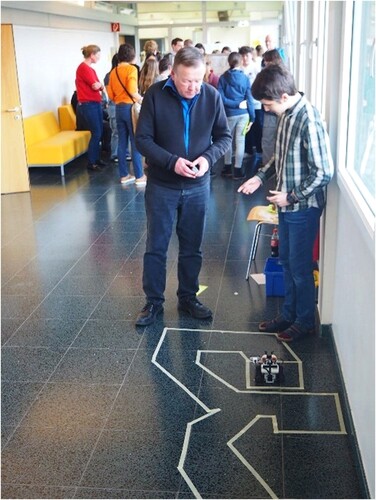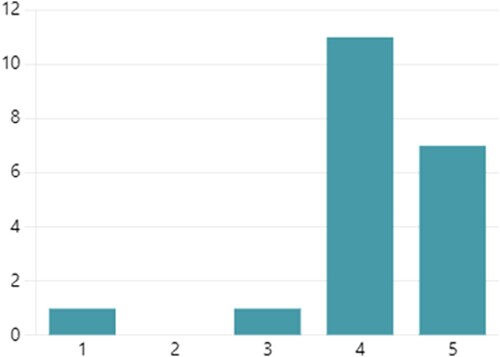Abstract
Take some secondary school students, leave the classroom, move around, add challenging tasks, let it ‘cook’, check consistency, and add hints if needed. Invite guests to taste what you ‘cooked’. This recipe serves two Grade 7 classes, four teachers, and forty-some relatives. This study is about a school project engaging students for two months in STEAM activities, namely, students planned the first settlements on Mars. The project involved various spaces: the classroom, the school, a virtual classroom, and a museum. We examined students’ involvement, motivation, the learning effect, and soft skills. We also studied the project’s impact on society, for instance, the involved families. The data were collected by using questionnaires based on the Likert scale, open-ended questions, focus groups and observations. We studied what factors make STEAM tasks motivating, the learning environments and the learning outcome. We found three key features: learning spaces, social settings, and meaningful tasks.
1. Starter: an introduction
Before cooking for a feast, you plan the menu, consider who is invited, and your guests’ likes and dislikes. Briefly, you get ready to prepare a nice meal. Similarly, our school project focused on settling down on Mars and the challenges faced by the first settlers. As the Mars project was quite complex, we will guide you through the stages so that you can get a real taste of the project. We start by looking back at the early stages of the project to give you an insight into how the project evolved. After attending a workshop on the STEAM (Science, Technology, Engineering, Art, Mathematics) approach based on the KIKS Erasmus project (Houghton et al., Citation2019) held by Houghton, three of my colleagues and I decided to try it out. On the one hand, we saw examples during the workshop of how kids could inspire other kids (KIKS) for STEAM activities. On the other hand, we had to cope with our not-too-motivated students, however, we hoped this would change thanks to the interesting STEAM activities. Our team included teachers from English, Biology, Physics and Mathematics. It took time to find a topic we could all contribute to, that was relevant to the curriculum and students could find interesting. As the solar system was on the menu in the Physics lesson, we decided to look for a related topic fitting the curriculum, and our interest. It also had to be manageable in the given time. We aimed to design a transdisciplinary project. Comparing multidisciplinary, interdisciplinary and transdisciplinary projects is similar to comparing the comparative and superlative forms of adjectives (Boaler, Citation2002). A multidisciplinary project involves many subjects studying the same problem without interaction between the subjects. An interdisciplinary project takes a step further by integrating views of one subject into another. Transdisciplinary projects seem to be the ‘superlative’, as interaction takes place between many subjects and even society can contribute to the project. We designed a transdisciplinary project by considering all the involved subjects and selecting a suitable topic. As biology is about life and living creatures, and what is necessary for life, we agreed on the topic of starting a new life on Mars with all the related problems. The teacher team agreed on a study plan: the biology teacher would study with the students, what you could grow on Mars; the physics teacher would discuss the solar system and the ideal time when to fly to Mars; the mathematics teacher would look into modelling and housing on Mars, the English teacher would practise how to present findings. This is how we started, and about the further steps you can read in the section about methods and task description. Before showing some recipes from our ‘cookbook’, we need a good base like fried onions for a stew, so first we outline the theoretical framework and provide definitions and a literature review. We then present our methods, activities, data collection, and findings, comparing them with the literature. We conclude this STEAMy meal with ideas for new recipes and ingredients to cook an even more richly spiced meal the next time.
2. Theoretical background and literature review
Before starting to cook, the kitchen must be prepared. Similarly, we had set the scene before starting to teach. We aim to study how learning environments and project-based STEAM tasks influence students’ motivation. Therefore, we need a theoretical framework and clear definitions like learning ecosystem or motivation.
2.1. Definitions
We define learning ecosystems by referring to Liljedahl and Zager (Liljedahl & Zager, Citation2021b) who defined learning environments as a complexity involving the students, the teachers, the content, how the task is presented and assessed/evaluated, and the physical space where teaching and learning take place. We add transdisciplinarity and time calling this a learning ecosystem. As we focus on students’ motivation, we need a suitable definition. There are more than 90 definitions of emotions (Kleinginna & Kleinginna, Citation1981), which implies that finding a definition is challenging, and the same applies to motivations. One can distinguish between extrinsic and intrinsic motivations (Deci & Ryan, Citation2000), given the difference between the sources of the motivation whether a student is motivated to please somebody or to pass an exam as opposed to the student’s interest. We focus on intrinsic motivation, which we define as the readiness to participate in activities for their own sake and enjoyment. This definition is central to our discussion of affective learning in the literature review. We interpret creativity as creating something new to oneself, an artefact or knowledge, aligning with the concept of everyday creativity as described by Gruner and Csikszentmihalyi (Citation2019).
2.2. Theoretical background
We base our study on the Theory of Didactic Situations (TDS), which examines the dynamic interplay between the educator, the learner and the learning environment (Artigue et al., Citation2014; Brousseau, Citation1997) forming a triangle whose sides represent the constant dynamic change between the components. We aim to study how these components influence each other. Additionally, we refer to constructionism, the learning theory claiming that students create knowledge by constructing their own solutions. The creative process allows students to practice and learn creativity (Papert, Citation2020; Resnick & Robinson, Citation2017). We also study the effect of creative tasks on motivation. We also consider the STEAM approach, which involves combining several disciplines (Aguilera & Ortiz-Revilla, Citation2021) and providing students with real-life problems from their surroundings. STEAM activities are well-suited for project-based learning (Krajcik & Blumenfeld, Citation2005) enabling students to engage in tasks for extended periods and work autonomously in groups. As our surroundings impact how we feel and act, it is crucial to discuss learning spaces. Liljedahl and Zager (Citation2021) emphasized the importance of the learning space, noting that even furniture arrangement matters. The teaching-learning context is influenced by space, time and the people involved. A learning ecosystem can be compared to holistic therapy, where the focus is on the whole body rather than just the symptomatic part. Similarly, a learning ecosystem includes students, teachers, content, space, and time, all influencing each other continuously. We will study learning spaces with this holistic approach. Research has shown that opening up traditional classroom settings with a dominant teacher lecturing in front of the class can enhance learning by allowing students to move around, and have more autonomy (Cahyono & Ludwig, Citation2019; Liljedahl & Zager, Citation2021). It was also found in numerous experiments that breaking away from the traditional forms, for instance, standing in front of a whiteboard and discussing the problems in smaller groups is beneficial for learning as described by Liljedahl and Zager (Citation2021) or by Los and Schweinle (Citation2019) who studied the teacher’s role in creating a motivating learning environment. Selecting TDS as our theoretical framework, along with constructionism and STEAM as learning approaches, provides a solid foundation for designing tasks, much like fried onions form the base of a good Hungarian goulash.
2.3. Literature review
We are interested in the effects of STEAM tasks and learning environments on students’ motivation and learning. Reviewing the literature reveals that both aspects have motivating effects and learning benefits. Picard and her colleagues at MIT (Citation2004) found that positive emotions enhance learning outcomes and founded a new research direction concerning affective learning. Numerous case studies demonstrate that STEAM tasks have a motivating effect (Conradty & Bogner, Citation2020; Suryaningsih et al., Citation2022). These tasks have a motivating effect by offering room for creativity (Conradty et al., Citation2020). Some tasks involve technology implementation (Alamri et al., Citation2020), while others enhance collaboration resulting in enhanced motivation (Karampa & Paraskeva, Citation2018). Additionally, numerous studies claim that well-designed learning environments can enhance learning (Boaler, Citation2016; Liljedahl & Zager, Citation2021). Liljedahl and Zager created ‘thinking classrooms’, meaning that students start thinking when provided with a challenging problem. They found that this positive impact can result from changing the physical or the social setting, the task design or the evaluation method. The authors claimed that anything is better than the traditional setting with a teacher in the front conducting the class seated behind desks (Boaler, Citation2002; Liljedahl & Zager, Citation2021). For instance, leaving the classroom and solving real-life STEAM tasks along a mathtrailFootnote1 (Cahyono & Ludwig, Citation2017) can be motivating for students. Allowing students to collaborate also benefits learning (Lave & Wenger-Trayner, Citation2020).
2.4. Hypothesis and research questions
Relying on the theoretical framework and literature review, we aim to answer the following questions:
RQ1: What makes STEAM tasks motivating?
RQ2: What makes a learning environment motivating?
RQ3: Does increased motivation positively influence learning outcomes?
3. Methods and data collection
As it is a design study, focusing on the effects of a design, it qualifies as design-based research. We aimed to use suitable methods for planning and conducting the lessons, as well as for collecting data. As you will see in the activities section, the tasks built on each other and the outcomes of one task influenced how we carried on. This resulted in small cycles of designing, acting, evaluating, and redesigning. Students gave feedback during the whole project and determined the next steps. The overarching structure involved giving students questions to work on in self-selected groups with deadlines for presenting their findings. Along the way, we introduced activities to provoke new questions. Students first presented their findings to the class and received feedback, which allowed them to refine their work before presenting their findings to a broader audience including their families and friends.
Data were collected using 5-point Likert scale questionnaires from students, visiting families, and involved teachers to gather information on their views regarding motivation, learning effects, and effects on soft skills. Additionally, open-ended questions allowed for elaboration, and focus groups and observations were conducted by the involved teachers. One of the students seemed particularly motivated and always exceeded our expectations. We will refer to him at several points to show how he approached or revisited a task. For convenience, we will call him Dave.
4. The Mars project
In this section, we add the ingredients to the stew by describing the activities in chronological order. We then analyse the learning environments in which the activities took place. To answer RQ1, we provided various activities as possible ingredients. To answer RQ2, we set different learning environments. From these, we aimed to answer RQ3 concerning the learning outcomes.
4.1. Preparatory phase
After agreeing on the project idea, we created a timeline for ourselves and the students involving two months in total. Initially, we provided input to introduce the main idea of settling down on Mars, discussing the travel time to get there, raising the question if Mars is suitable to live there and the vital factors for survival. Then, students were given time both in and out of class to form groups and select a question they wanted to work on. To facilitate cooperation within and between groups, we created a Padlet as a collaborative workspace (Figure ). Some groups were interested in the climate, some in housing, what you can grow on Mars, and what outfits may be suitable. One group even discussed whether there would be one common language and religion for all settlers considering they would come from different nations.
4.2. Astronaut training and sleepover at school
While students were learning about the solar system in their regular physics lessons, we organized a sleepover at school dedicated to astronaut training. There were various stations where students could experience the conditions astronauts must endure. The goal was to raise their awareness of the challenges faced by astronauts, such as quick decision-making, readiness for repairing and managing weightlessness. These ideas guided the design of the stations.
Station 1: Reaction time – One student lets a rod fall unexpectedly, and another student must catch it.
Station 2: Balancing – Students stand on one foot while balancing on an air-filled pillow.
Station 3: First Aid – Students learn how to give first aid by placing someone in a stable side-lying position.
Station 4: Weightlessness – Students eat carrots and sweets hanging in the air without using their hands.
Station 5: Repairing in a space suit – Students build a tower as high as possible while wearing big gloves.
Station 6: Slowing down the landing – Students design and make a parachute to ensure an egg lands without breaking, simulating equipment landing on Mars.
After the training, we socialized by watching ‘The Martian’, a movie about a biologist surviving on Mars for a few months and eating pizza. Figure and Figure give insights into the activities and the stations.
4.3. Building a rocket
In a physics lesson, students discussed how a rocket works, and in a mathematics lesson, we built a rocket using a plastic bottle, lemon acid, and baking powder. In the schoolyard, we added water, closed the bottle with a cork, and when enough gas was produced, the rocket launched (Figure ). Each group attempted to launch a rocket, and by determining the average of the heights measured, we aimed to determine the expected flight height. Unfortunately, only two groups succeeded in launching their rockets, and in the excitement, we failed to measure the heights the rockets reached. From that aspect, the learning goal was not fully achieved. However, one student was particularly enthusiastic about the experiment and disappointed by our lack of success. This student, already referred to as Dave, made a learning video (Figure ), explained how the experiment worked, and carried it out successfully at home.
4.4. Housing and a geodesic dome
In a maths class, we discussed the weather conditions on Mars, noting that because of the heavy storms, Martian houses need to be as stable as those on Earth in earthquake-prone areas. We explored solid constructions and building methods. One group chose this topic and learnt about the geodesic dome, a structure known for its stability and where this construction is used. The mathematics teacher introduced this concept intending to build one with both classes and discuss the related mathematical questions. Both classes built their own geodesic dome using newspapers following instructions you can find for instance in teachers’ resources (Activity: Geodesic Dome Handout, Citation2023). Paper rods were rolled and stuck together to form triangles (Figure , , ). This structure is very solid due to the numerous triangles. It is a team-building activity with significant mathematical content. We discussed several mathematical questions: the number of triangles forming the surface of the geodesic dome, the surface area of the model geodesic dome, the actual surface area if you build it large, and methods to determine the volume. Students had various ideas:
Building a small solid model, weighing it, and using its density to work out the volume, then scaling up to get the volume of the real building.
Filling the model with water or gas and measuring the volume used.
Estimating the actual volume by filling the model with large cubes.
Dave took this project further. He designed a model using Tinkercad and printed his model using a 3D printing pen as you can see in Figure and Figure .
4.5. Presentations
Students refined their research findings and prepared their presentations in both German and English. They first presented in class, where their presentations were discussed and commented on, allowing them to finalize their work. After two months of preparation, families were invited to a presentation event where students showcased their findings. Some students prepared interactive quizzes for the visitors to check their knowledge about Mars. Dave even conducted a survey to see how many students and adult visitors would be willing to settle on Mars. 14 stations were covering various topics, including a crafting station and one where visitors could get a driving licence for a small robot. This two-hour session served as the closing event of the project. The following figures (Figure , , , ) give an insight into the presentation event.
4.6. Excursion: visiting the Zeppelin Museum
To wrap up the project, we organized an excursion to the Zeppelin Museum in Friedrichshafen in Germany, located about one and a half hours from our school by public transportation. The museum, dedicated to flying, aviation, and the life of Count Zeppelin, provided a challenging quiz to make the museum visit more interesting. Students received questions to answer during their visit. While searching for the answers, students learned about the early history of flying, which was a fitting closing for the project.
4.7. The learning environments
Maybe, we should call this section ‘the kitchen’, to extend the metaphor of cooking a nice meal. However, unlike cooking, where you typically have a single scene, our project involved several scenarios. As the project developed, we moved from a very short input phase with a teacher figure dominating the scene, through open discussions in smaller groups and between the groups both using a virtual online platform, Padlet, the classroom and the school building. Moving around and walking up to somebody belonged to collaboration and was self-evident. Opening up the learning environment by placing the students in the front and making the students responsible for selecting what, where and how to present and keeping the teachers backstage to ask for suggestions created a learning environment different from the usual classroom setting from various aspects. The physical and the social arrangements were different, the roles were different, and the tasks were different. However, the objective remained the same: to learn and teach. This learning environment became even more complex by adding ‘outsiders’ to it. Parents, who typically wouldn’t enter the school beyond the pick-up area, were invited to participate for a short period. This broadened the learning community. Leaving our small town and visiting the museum provided another layer of context and a different kind of learning environment.
5. Data collection
To assess factors that may make STEAM tasks and learning environments motivating, students completed a 5-point Likert scale questionnaire (1 standing for strongly disagree and 5 standing for strongly agree) and open-ended questions during the project and after the presentations. Parents attending the presentations and teachers involved also received similar questionnaires. Table presents sample questions, average scores and the standard deviation.
Table 1. Sample questions from the questionnaire.
Analysing open-ended responses, students enjoyed ‘working in teams’ the most, followed by having a free choice of topic, and finally, presenting their results. Dave said he appreciated that instead of preparing a boring presentation following strict guidelines, they could decide what to present and how to present it.
To answer RQ3, we refer to the results of an informal competence check carried out in both classes involved in the Mars project. In Austria, all students in Grades 3, 4, 6 and 7 participate in an online competence test involving three subjects: English, German as their mother tongue and Mathematics. Table shows the results of this national informal competence test in Austria (IKM Plus) (Institut des Bundes für Qualitätssicherung im österreichischen Schulwesen, Citation2024). A new national curriculum will be introduced in 2024 and the Austrian government wanted an insight into the current state of students’ competencies. The table shows the average scores for both classes compared to the national average in 2022 and 2023. In both years, the maximum score was 220. The national average can be viewed as the results of a control group.
Table 2. National Austrian Competence test results.
Table shows that both classes were above the average in both years. An increase is expected from one year to the other, however, this increase seems to be greater by these two classes in comparison with the national average and class 1 excelled in this increase in comparison with the grammar schools too.
Dave’s results show a potential connection between students’ competence and motivation in the project as addressed in RQ3. Dave scored 173 points in 2022 and 208 points in 2023. In both years, 2020 points were the maximum. His scores increased by 35 points, whereas the Austrian national average increased just by 9 points and in grammar schools by 12 points.
Students’ answers to the question if they wanted to participate in a similar project had an average score of 4.15 on the 5-point Likert scale, which we consider as a positive overall evaluation of the project.
6. Results
Considering RQ1 about motivation, the data suggests that students’ motivation increased, they participated actively in the project, realized that it was an interdisciplinary STEAM project and thought that this kind of project could enhance their learning. Surprisingly, the visiting adults and the involved teachers were more positive concerning the learning outcomes as Table shows. While students initially were slightly worried about presenting in English, they gained confidence after receiving praise from the visitors. Ultimately, they even felt proud and satisfied. Adults seemed to enjoy witnessing students’ activities and participating in school life. These positive experiences, combined with feedback from friends, family and teachers resulted in a high average score (4.15 on a 5-point Likert scale) for their willingness to participate in a similar project in the future. We didn’t speak about the involved teachers as it is beyond the scope of this study, however, the positive feedback convinced the involved teachers too that it was worth the time and the efforts, and they would be ready to conduct similar projects in the future. Considering RQ2, students seem to appreciate freedom above everything else and it is reflected in their preferences concerning the physical and the social settings. Working in groups in open spaces permitting moving around and collaborating seem to be the key factors. As for RQ3, concerning the learning effect, we refer to the national Austrian informal competence test, IKM Plus (Institut des Bundes für Qualitätssicherung im österreichischen Schulwesen, Citation2024). While we cannot definitively attribute the IKM Plus test results to the project, the Mars project was part of the students’ life for two months and it may have had some influence. Notably, Dave, a highly engaged student who went above and beyond, achieved outstanding results in the test. The facts are that we had a project-based learning experience based on an interdisciplinary STEAM task and we had a positive increase in the competence test, especially in the competence areas of reasoning, geometry and solids, and modelling.
7. Discussion
This study investigated the impact of STEAM tasks on student motivation and learning. We found that STEAM tasks, characterized by their interdisciplinary nature, can enhance student motivation. Similar to how spices enrich a stew, STEAM tasks can add rich dimensions to learning by encouraging creativity, teamwork, collaboration and problem-solving skills. These findings align with existing research (Houghton et al., Citation2019; Papert, Citation2020; Resnick & Robinson, Citation2017). Let us refer back to Picard and her colleagues (Citation2004) who found that positive emotions enhance motivation resulting in a positive learning outcome. The results of the competence test are surely due to many factors, however, the Mars project lasting over two months and involving many activities may be part of the results. We found answers to the research questions: (1) pick the ingredients carefully, that is, creative, collaborative, real-life STEAM tasks; (2) select the right place where to cook and how to cook, preferably in the garden for a longer time to enjoy freedom; (3) the results seem to evidence a positive learning effect.
8, Conclusion
It took a long time and needed many ingredients to cook this meal. The posters and other utensils used for the presentations vanished just like a delicious meal disappears quickly when many people celebrate together, however, the memories, a good taste in the mouth remained. Figure shows students’ answers to the question if they wanted a second serving.
Students’ motivation and positive feedback motivated our teacher team, we started working on a new project ‘Sun, Water and Wind’ and more colleagues and classes joined. What is the reason for the motivating effect? Room, time and freedom to be creative and that with friends and family.
We conclude that we must go on, we need to cook a new meal, the first one was hoovered up too quickly.
Coming back to the research questions, transforming the learning ecosystem into a dynamically evolving union of students, teachers, cooperating small groups, interesting learning spaces, and creative tasks seem to have a motivating effect and higher motivation seems to enhance learning. However, it needs further research, ‘cooking some more meals’ to find out more details about these complex learning ecosystems, and why and how they work.
Disclosure statement
No potential conflict of interest was reported by the author(s).
Notes
1 A path students can walk along and solve problems related to the surroundings.
References
- Activity: Geodesic Dome Handout. (2023, June 27). https://www.pbs.org/wgbh/buildingbig/educator/act_geodesic_ho.html.
- Aguilera, D., & Ortiz-Revilla, J. (2021). Stem vs. steam education and student creativity: A systematic literature review. Education Sciences, 11(7), 331. https://doi.org/10.3390/educsci11070331
- Alamri, H., Lowell, V., Watson, W., & Watson, S. L. (2020). Using personalized learning as an instructional approach to motivate learners in online higher education: Learner self-determination and intrinsic motivation. Journal of Research on Technology in Education, 52(3), 322–352. https://doi.org/10.1080/15391523.2020.1728449
- Artigue, M., Haspekian, M., & Corblin-Lenfant, A. (2014). Introduction to the theory of didactical situations (TDS). In Networking of theories as a research practice in mathematics education (pp. 47–65). Springer. https://doi.org/10.1007/978-3-319-05389-9_4
- Boaler, J. (2002). The development of disciplinary relationships: Knowledge, practice and identity in mathematics classrooms. For the Learning of Mathematics, 22, 42–47. https://www.jstor.org/stable/40248383.
- Boaler, J. (2016). Designing mathematics classes to promote equity and engagement. The Journal of Mathematical Behavior, 41, 172–178. https://doi.org/10.1016/j.jmathb.2015.01.002
- Brousseau, G. (1997). Theory of didactical situations in mathematics (N. Balacheff, M. Cooper, R. Sutherland, & V. Warfield, Eds. & Trans.). Kluwer.
- Cahyono, A. N., & Ludwig, M. (Eds.). (2017). Examining motivation in mobile app-supported math trail environments. In CERME 10.
- Cahyono, A. N., & Ludwig, M. (2019). Teaching and learning mathematics around the city supported by the Use of digital technology. Eurasia Journal of Mathematics, Science and Technology Education, 15, em1654. https://doi.org/10.29333/ejmste/99514
- Conradty, C., & Bogner, F. X. [Franz Xaver]. (2020). Steam teaching professional development works: Effects on students’ creativity and motivation. Smart Learning Environments, 7(1), 1–20. https://doi.org/10.1186/s40561-020-00132-9
- Conradty, C., Sotiriou, S. A., & Bogner, F. X. [Franz X.]. (2020). How creativity in STEAM modules intervenes with self-efficacy and motivation. Education Sciences, 10(3), 70. https://doi.org/10.3390/educsci10030070
- Deci, E. L., & Ryan, R. M. (2000). The “what” and “why” of goal pursuits: Human needs and the self-determination of behavior. Psychological Inquiry, 11(4), 227–268. https://doi.org/10.1207/S15327965PLI1104_01
- Gruner, D. T., & Csikszentmihalyi, M. (2019). Engineering creativity in an age of artificial intelligence. In The Palgrave handbook of social creativity research (pp. 447–462). Palgrave Macmillan. https://doi.org/10.1007/978-3-319-95498-1_27
- Houghton, T., Oldknow, A., Diego-Mantecón, J. M., Fenyvesi, K., Crilly, E., & Lavicza, Z. (2019). Kiks creativity and technology for all. Open Education Studies, 1(1), 198–208. https://doi.org/10.1515/edu-2019-0014
- Institut des Bundes für Qualitätssicherung im österreichischen Schulwesen. (2024, February 15). Onlineplattform iKM PLUS. https://www.iqs.gv.at/themen/nationale-kompetenzerhebung/onlineplattform-ikm-plus.
- Karampa, V., & Paraskeva, F. (2018). A motivational design of a flipped classroom on collaborative programming and STEAM. In L. Uden, D. Liberona, & J. Ristvej (Eds.), Communications in computer and information science: Vol. 870, learning technology for education challenges: 7th international workshop, LTEC 2018, Žilina, Slovakia, August 6–10, 2018, proceedings (pp. 226–238). Springer. https://doi.org/10.1007/978-3-319-95522-3_19
- Kleinginna, P. R., & Kleinginna, A. M. (1981). A categorized list of emotion definitions, with suggestions for a consensual definition. Motivation and Emotion, 5(4), 345–379. https://doi.org/10.1007/BF00992553
- Krajcik, J. S., & Blumenfeld, P. C. (2005). Project-based learning. In The Cambridge handbook of the learning sciences (1st ed., pp. 317–334). Cambridge University Press. https://doi.org/10.1017/cbo9780511816833.020
- Lave, J., & Wenger-Trayner, É. (2020). Situated learning: Legitimate peripheral participation (31st printing, first published 1991). Learning in doing: Social, cognitive, and computational perspectives. Cambridge University Press.
- Liljedahl, P., & Zager, T. (2021). Building thinking classrooms in mathematics: 14 teaching practices for enhancing learning: Grades K-12. Corwin Mathematics. Corwin.
- Los, R., & Schweinle, A. (2019). The interaction between student motivation and the instructional environment on academic outcome: A hierarchical linear model. Social Psychology of Education, 22(2), 471–500. https://doi.org/10.1007/s11218-019-09487-5
- Papert, S. A. (2020). Mindstorms: Children, computers, and powerful ideas. Basic books.
- Picard, R. W., Papert, S., Bender, W., Blumberg, B., Breazeal, C., Cavallo, D., Machover, T., Resnick, M. [M], Roy, D., & Strohecker, C. (2004). Affective learning — A manifesto. BT Technology Journal, 22(4), 253–269. https://doi.org/10.1023/B:BTTJ.0000047603.37042.33
- Resnick, M. [Mitchel], & Robinson, K. (2017). Lifelong kindergarten: Cultivating creativity through projects, passion, peers, and play. MIT Press.
- Suryaningsih, S., Nisa, F. A., Muslim, B., & Aldiansyah, F. (2022). Learning innovations: Students’ interest and motivation on STEAM-PjBL. International Journal of STEM Education for Sustainability, 2(1), 66–77. https://doi.org/10.53889/ijses.v2i1.40

